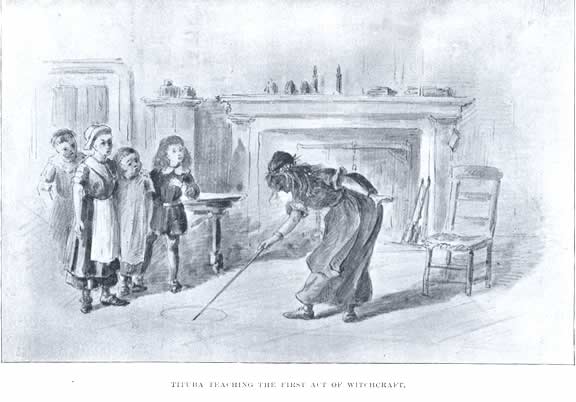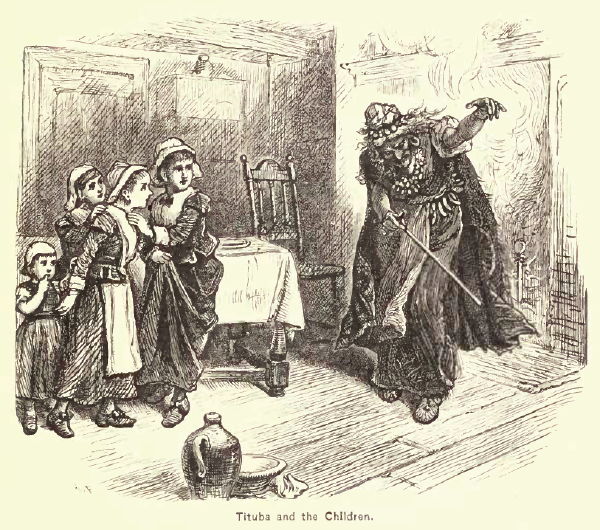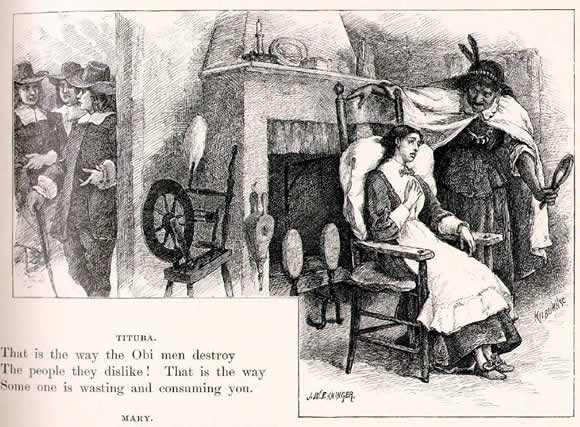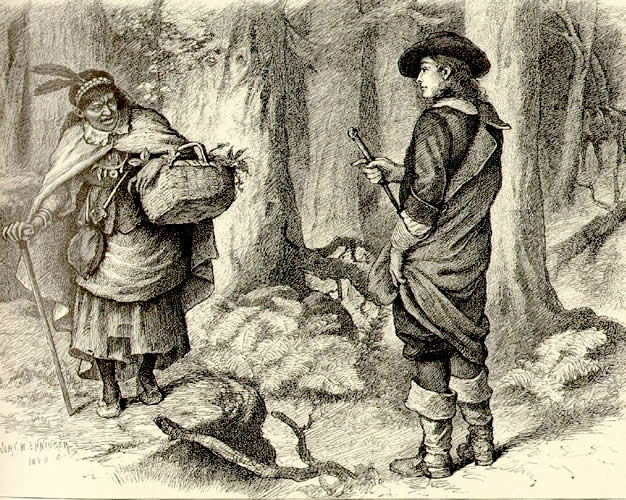Tituba was a slave who worked for Samuel Parris during the Salem Witch Trials of 1692.
The various documents and books about the Salem Witch Trials over the years often refer to Tituba as black or mixed race but the actual court documents from her trial refer to her as an “Indian woman, servant.”
Tituba’s Early Life:
Not much is known about Tituba’s life except that she was born in an Arawak Village in South America where she was captured during her childhood and taken to Barbados as a slave.
Parris, or an associate, later purchased her in Barbados when she was a teenager and brought her to Boston in 1680.
In November of 1689, Samuel Parris moved Tituba and his family to Salem after he was appointed the new minister of Salem Village.
Tituba & the Salem Witch Trials:
Over a decade later, Tituba was one of the first women to be accused of witchcraft during the hysteria of 1692.
Some sources suggest Tituba was named a witch because she allegedly practiced voodoo and taught the Salem Village girls fortune telling, but there are no references to this in the court records and no evidence that she did this.

What the court records do indicate is that when Parris’ daughter Betty and her cousin Abigail Williams started experiencing strange fits and complaining of pain in February of 1692, Tituba and her husband John helped a neighbor named Mary Sibley bake a witch cake, a cake made from rye meal and the afflicted girl’s urine, and fed it to a dog hoping it would reveal the name of whoever bewitched the girls.
The girl’s symptoms took a turn for the worse and just a few weeks after the incident they accused Tituba, Sarah Good and Sarah Osburn of bewitching them. The three women were promptly arrested.
The Salem Witch Trials would have ended with those three arrests but the events of Tituba’s examination by Judge John Hathorne in March sparked a massive witch hunt, according to the book Tituba: The Reluctant Witch of Salem:
“The epidemic of strange behaviors and accusations did not spread to other victims until after Tituba’s arrest and her several testimonies beginning on March 1. March 5, the conclusion of Tituba’s remarkable confession, marked a new chapter in the witchhunt episodes of New England…Tituba’s confession is the key to understanding why the events of 1692 took on such epic significance.”
It was this confession and her dramatic testimony that convinced the people of Salem that this was not an isolated incident and that the Devil had invaded Salem:
“[Hathorne]: Tituba what evil spirit have you familiarity with?
[Tituba]: None
[Hathorne]: Why do you hurt these children?
[Tituba]: I do not hurt them
[Hathorne]: Who is it then?
[Tituba]: The devil for ought I know
[Hathorne]: Did you never see the devil?
[Tituba]: The devil came to me and bid me serve him
[Hathorne]: Who have you seen?
[Tituba]: Four women sometimes hurt the children
[Hathorne]: Who were they?
[Tituba]: Goody Osburn and Sarah Good and I doe not know who the other were Sarah Good and Osburne would have me hurt the children but I would not she further saith there was a tale man of Boston that she did see
[Hathorne]: When did you see them?
[Tituba]: Last night at Boston
[Hathorne]: What did they say to you they said hurt the children?
[Hathorne]: And did you hurt them?
[Tituba]: No there is four women and one man they hurt the children and then lay all upon me and they tell me if I will not hurt the children they will hurt me
[Hathorne]: But did you not hurt them?
[Tituba]: Yes, but I will hurt them no more
[Hathorne]: Are you not sorry you did hurt them?
[Tituba]: Yes.
Tituba went on to describe conversations she had with evil pigs, dogs and rats who all ordered her to do their bidding and said she personally witnessed Sarah Good and Sarah Osbourne transform into strange, winged creatures.

There are many reasons why Tituba may have made these dramatic confessions. Many sources, including Tituba herself, indicate she was forced to confess after being beaten by Parris.
Also, as a slave with no social standing, money or personal property in the community, Tituba had nothing to lose by confessing to the crime and probably knew that a confession could save her life.
It is not known what religion Tituba practiced, but if she was not a Christian she had no fear of going to hell for confessing to being a witch, as the other accused witches did.

Since Tituba confessed, her case never went to trial and she was spared the gallows. According to the book Tituba: The Reluctant Witch of Salem, Tituba remained in jail but as the witch trials continued, she retracted her confession:
“At the end Tituba recanted her confession, admitting that she had lied to protect herself. That action had little effect on the subsequent events and was almost lost in the rush by other confessors, in fear of damnation, to admit their terrible sin. Tituba’s attempt to retract her confession received scant attention at the time and was ignored in the written reports of most observors. Only Robert Calef made note of it: ‘The account she [Tituba] since gives of it is, that her Master did beat her and otherways abuse her, make her confess and accuse (such as he call’d) her Sister-Witches, and that whatsoever she said by way of confession or accusing others, was the effect of such usage.’ Hers was not the first retraction of a reluctant confession. The others had already received a great deal of attention.”
On May 9, 1692, a grand jury in Ipswich declined to indict Tituba, writing “ignoramus” on her paperwork, indicating she was found not guilty due to a lack of evidence.
Tituba After the Salem Witch Trials:
Tituba remained in jail in Boston because Parris refused to pay her jail fees, for reasons unknown. It is possible he wanted to be rid of her because she served as a reminder of the witch trials or because he was angry at her for recanting her confession.

In April of 1693, Tituba was sold to an unknown person for the price of her jail fees. It is also assumed her husband, John, was sold along with her. It is not known what happened to Tituba or John after this date.
The site of the Salem Village Parsonage, where Tituba lived at the time of the Salem Witch Trials, was excavated in 1970 and is open to visitors.
Tituba Historical Sites:
Salem Village Parsonage Archaeological Site
Address: Rear 67 Centre Street, Danvers, Ma (site is accessible via a cart path)
Sources:
Calef, Robert. More of the Wonders of the Invisible World. 1700
“Frequently Asked Questions.” Salem Witch Museum, www.salemwitchmuseum.com/education/faqs
Encyclopedia of African American History, Volume 1. Edited by Leslie Alexander, ABC-CLIO, LLC,, 2010
Norton, Mary Beth. In the Devil’s Snare: The Salem Witchcraft Crisis of 1692. Vintage Books, 2003
Breslaw, Elaine G. Tituba, Reluctant Witch of Salem: Devilish Indians and Puritan Fantasies. New York University Press, 1997

good
Oh My God, this is a really website can I find more. but how can I thank you daisha rosario